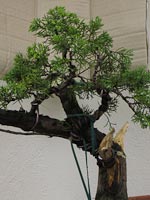Air Layering
+4
Sorcertree
leatherback
JimLewis
joewebb
8 posters
Page 1 of 1
 Air Layering
Air Layering
Hey everyone, just a quick question, when is a suitable time to sever a air layer after successful rooting.
Cant seem to find any articles with regards to this on the internet. Can this be done at any time on ever-green trees & spring/summer for deciduous trees as according to me the air layered section is completely independent of the original roots thus there is no sap flowing & no risk of killing of the new section.
Cant seem to find any articles with regards to this on the internet. Can this be done at any time on ever-green trees & spring/summer for deciduous trees as according to me the air layered section is completely independent of the original roots thus there is no sap flowing & no risk of killing of the new section.

joewebb- Member
 Re: Air Layering
Re: Air Layering
Most any time during the growing season is OK. BUT . . . Air layering neophytes almost always mis-define "successful" rooting and cut it off too early. The plastic wrap/pot should be jam filled with roots; a few visible thru the plastic isn't enough.
The later in the season you cut, the more likely it will require a bit of protection in the coldest days of winter.
The later in the season you cut, the more likely it will require a bit of protection in the coldest days of winter.

JimLewis- Member
 Re: Air Layering
Re: Air Layering
Jims advice is sound, and the best way to go about it; It should have similar amounts of root as you would leave on when repotting.. Sometimes you just have to remove an airlayer, e.g., when taking layers in an exposed, public site, or in an area that is going to be cut down at some point. I take layers of plants also in public areas, and like to get them off as soon as rooting has started to show all around the trunk, with roots sometimes as short as 1cm / .5 inch. The time of year.. Ideal time for me.. No ideal time. Mid-to-late summer: Tree is in full growth, and as such can recover form a cut quickly. However, it is in full leaf and has high water demands. In mid/late winter, the tree is dormant, and cannot seal cut areas as well. However, demands on the roots are low, and as soon as growth starts, it will quickly send out roots as needed for leafing out.
Most people seem to find severing a layer in late summer to be best, but only if another 6-8 weeks of active growth is still possible before winter conditions..
Personally, I sever when the rooting is sufficient. What works, I find, really depends on the species. I have sucessfully potted up air-layers of Juniper with as little as 3 roots of 1cm (.5 inch), and have had failures with creatagus with a good handfull of roots. This I think depends really on the aftercare & conditins one can provide.
Main thing is to be VERY carefull not to disturb the roots when potting up. These new roots can be very brittle. Just rotating the trunk a little may cause all the new roots to snap, setting you back several weers, and often klling the layer. Therefor, I do not work on the bottom stump, but rather use it to fix the layer in the pot. Next spring, after good growth, I repot and work on the stump. This way, the newly potted up pllant cannot move.
The less rooting has taken place, the more you need to treat it as a cutting.

leatherback- Member
 Re: Air Layering
Re: Air Layering
Leatherback,
I want to attempt a cratageus a\l. Any pointers?
Also, the dealing with the stump later made me think. .....
One could drill holes and run wires through the stump, somewhere in the middle of the ringbarking, before airlayer.
This way, you don't have to worry about damaging roots after removal. Just pull the wire down and tie off.
Also, it could serve as a guide for the saw when it does come time to severe it.
Sorce
I want to attempt a cratageus a\l. Any pointers?
Also, the dealing with the stump later made me think. .....
One could drill holes and run wires through the stump, somewhere in the middle of the ringbarking, before airlayer.
This way, you don't have to worry about damaging roots after removal. Just pull the wire down and tie off.
Also, it could serve as a guide for the saw when it does come time to severe it.
Sorce
Sorcertree- Member
 Re: Air Layering
Re: Air Layering
Nope. no pointers, as mine died 
I have put a wire through the vertical middle of the pot, with a loop in the middle, in the size of the stump: You fill the pot partially with substrate, lower the stump through the loop of wire, and attach the top to the pot too. Then you fill up the rest of the pot with substrate. In other cases I have used a piece of plywood with a suitable hole in the middle in similar fasion. Big benefit of the latter: The roots will grow out horizontally.
Typical cutting moment:

Potted up:

I have put a wire through the vertical middle of the pot, with a loop in the middle, in the size of the stump: You fill the pot partially with substrate, lower the stump through the loop of wire, and attach the top to the pot too. Then you fill up the rest of the pot with substrate. In other cases I have used a piece of plywood with a suitable hole in the middle in similar fasion. Big benefit of the latter: The roots will grow out horizontally.
Typical cutting moment:

Potted up:


leatherback- Member
 Re: Air Layering
Re: Air Layering
leatherback wrote: In other cases I have used a piece of plywood with a suitable hole in the middle in similar fasion. Big benefit of the latter: The roots will grow out horizontally.
thats a damn good idea !
makes me think that one could even skip the hole in the board and just run a screw up through the board and into the stump...

Kevin S - Wisco Bonsai- Member
 Air Layering
Air Layering
Hey guys, thanx alot for the advice given, it is about mid summer here in SA & judging from the advice given it should still be safe to do the cut & potting.
Will post a pic of the air layer tomorrow.
Will post a pic of the air layer tomorrow.

joewebb- Member
 Re: Air Layering
Re: Air Layering
Keep in mind though, that if you wait too long, the roots will circle the pot and become impossible to untangle later. This will set you back and potentially negate the entire process. This is mainly an issue with vigorous species such as most acer.

prestontolbert- Member
 Re: Air Layering
Re: Air Layering
Because of my shorter growing season, less than 120 days, as opposed to California and other warmer regions, when air layering Japanese Black Pines, it is not unusual for the process to take two summers before being able to sever the air layer off the main tree.
By the way, I don't change how I winter the tree while the air layer is in process. I do protect JBP from extreme cold, but it can and does experience moderate freezing before being put into the unheated well house. And it can dip to 25 F or - 4 C in the well house. That is not cold enough to hurt new roots. Outdoors it can dip to -10 F (-23 C) or colder, so the well house is significant protection, but it does drop below freezing regularly.
By the way, I don't change how I winter the tree while the air layer is in process. I do protect JBP from extreme cold, but it can and does experience moderate freezing before being put into the unheated well house. And it can dip to 25 F or - 4 C in the well house. That is not cold enough to hurt new roots. Outdoors it can dip to -10 F (-23 C) or colder, so the well house is significant protection, but it does drop below freezing regularly.

Leo Schordje- Member
 Air Layering
Air Layering
prestontolbert wrote:Keep in mind though, that if you wait too long, the roots will circle the pot and become impossible to untangle later. This will set you back and potentially negate the entire process. This is mainly an issue with vigorous species such as most acer.
Nice to know as the layering might be on its way at achieving this as the photo indicates, might be to late already? A chop sooner than later is definitively needed then.

Took about 3 and a half weeks for this amount of rooting to be achieved, is this normal as I've been patiently waiting on another layering of a wild olive for almost 4 months now to get to the amount of rooting the acer achieved in just more than 3 weeks.
Leo, we are fortunate here in SA as our winters here in the inland seldom dip below -3C.

joewebb- Member
 Re: Air Layering
Re: Air Layering
Joe-
That doesn't look too bad. Those roots are still white and very fragile. I was only warning about allowing a layer to go for a very long time before removing. I waited much too long with a group of A. palmatum, and the roots lignified to the extent that I had to remove most of those roots the following year. About 1/3 died and the rest were dramatically weakened. You still have some time before that happens.
That doesn't look too bad. Those roots are still white and very fragile. I was only warning about allowing a layer to go for a very long time before removing. I waited much too long with a group of A. palmatum, and the roots lignified to the extent that I had to remove most of those roots the following year. About 1/3 died and the rest were dramatically weakened. You still have some time before that happens.

prestontolbert- Member
 Re: Air Layering
Re: Air Layering
Preston makes a good point. White roots are fragile and too delicate to work with. It's much better to wait until the roots are tan.prestontolbert wrote:Joe-
That doesn't look too bad. Those roots are still white and very fragile. I was only warning about allowing a layer to go for a very long time before removing. I waited much too long with a group of A. palmatum, and the roots lignified to the extent that I had to remove most of those roots the following year. About 1/3 died and the rest were dramatically weakened. You still have some time before that happens.
Bruce Winter- Member
 Similar topics
Similar topics» Air Layering
» air-layering jbp
» Wild material styling
» Air Layering
» How to air layer feroniella lucida or wood apple
» air-layering jbp
» Wild material styling
» Air Layering
» How to air layer feroniella lucida or wood apple
Page 1 of 1
Permissions in this forum:
You cannot reply to topics in this forum






